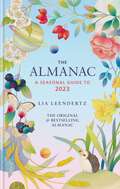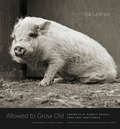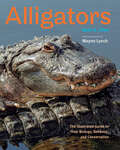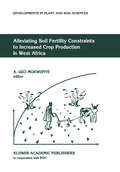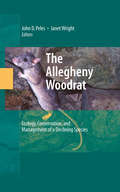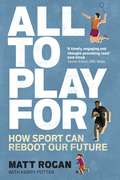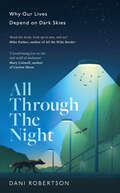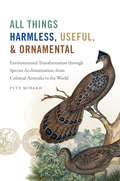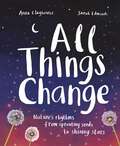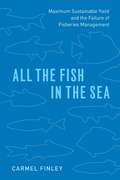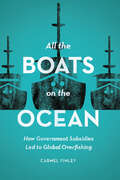- Table View
- List View
The Almanac: THE SUNDAY TIMES BESTSELLER (Almanac)
by Lia LeendertzTHE ORIGINAL & SUNDAY TIMES BESTSELLING ALMANAC Reconnect with the seasons in Britain and Ireland with this month-by-month guide to the world around us - including key dates, tide tables and garden tasks; constellations and moon phases; sunrises, folk songs, seasonal recipes plus a 'bun of the month'; and - because 2023 will be a good year for planet spotting - the solar system and the zodiac.The Almanac: A Seasonal Guide to 2023 gives you the tools and inspiration you need to celebrate, mark and appreciate each month of the year in your own particular way. Divided into the 12 months, a set of tables each month gives it the feel and weight of a traditional almanac, providing practical information that gives access to the outdoors and the seasons, perfect for expeditions, meteor-spotting nights and beach holidays. There are also features on each month's unique nature, with this instalment following the swirling micro world of the garden pond through the year.You will find yourself referring to The Almanac all year long, revisiting it again and again, and looking forward to the next edition as the year draws to a close.This year's edition is illustrated by artist Whooli Chen.The geographical scope of The Almanac is Britain and IrelandPRAISE FOR THE ALMANAC:'Lia Leendertz's classic almanac never fails to delight' - The Herald'It's a perfect Christmas present' - Allan Jenkins, The Observer'The perfect companion to the seasons' - India Knight'Indispensable' - Sir Bob Geldof'This book is your bible' - The Independent'I love this gem of a book' - Cerys Matthews
The Almanac: A Seasonal Guide To 2018 (Almanac)
by Lia LeendertzThe original and bestselling almanacReconnect with the seasons in Britain and Ireland with this month-by-month guide to the world around us - including tide tables, sunrises and moon phases; wildlife and folklore; seasonal recipes and more.The Almanac: A Seasonal Guide to 2025 gives you the tools and inspiration you need to celebrate, mark and appreciate each month of the year in your own particular way.Divided into the 12 months, a set of tables each month gives it the feel and weight of a traditional almanac, providing practical information that gives access to the outdoors and the seasons, perfect for expeditions, meteor-spotting nights and beach holidays. And it's the ideal gift!You will find yourself referring to The Almanac all year long, revisiting it again and again, and looking forward to the next edition as the year draws to a close.PRAISE FOR THE ALMANAC:'Lia Leendertz's classic almanac never fails to delight' - The Herald'It's a perfect Christmas present' - Allan Jenkins, The Observer'The perfect companion to the seasons' - India Knight'Indispensable' - Sir Bob Geldof'This book is your bible' - The Independent'I love this gem of a book' - Cerys Matthews
Allowed to Grow Old: Portraits of Elderly Animals from Farm Sanctuaries
by Isa LeshkoThere’s nothing quite like a relationship with an aged pet—a dog or cat who has been at our side for years, forming an ineffable bond. Pampered pets, however, are a rarity among animals who have been domesticated. Farm animals, for example, are usually slaughtered before their first birthday. We never stop to think about it, but the typical images we see of cows, chickens, pigs, and the like are of young animals. What would we see if they were allowed to grow old? Isa Leshko shows us, brilliantly, with this collection of portraits. To create these portraits, she spent hours with her subjects, gaining their trust and putting them at ease. The resulting images reveal the unique personality of each animal. It’s impossible to look away from the animals in these images as they unforgettably meet our gaze, simultaneously calm and challenging. In these photographs we see the cumulative effects of the hardships of industrialized farm life, but also the healing that time can bring, and the dignity that can emerge when farm animals are allowed to age on their own terms. Each portrait is accompanied by a brief biographical note about its subject, and the book is rounded out with essays that explore the history of animal photography, the place of beauty in activist art, and much more. Open this book to any page. Meet Teresa, a thirteen-year-old Yorkshire Pig, or Melvin, an eleven-year-old Angora Goat, or Tom, a seven-year-old Broad Breasted White Turkey. You’ll never forget them.
Allowed to Grow Old: Portraits of Elderly Animals from Farm Sanctuaries
by Isa LeshkoThere’s nothing quite like a relationship with an aged pet—a dog or cat who has been at our side for years, forming an ineffable bond. Pampered pets, however, are a rarity among animals who have been domesticated. Farm animals, for example, are usually slaughtered before their first birthday. We never stop to think about it, but the typical images we see of cows, chickens, pigs, and the like are of young animals. What would we see if they were allowed to grow old? Isa Leshko shows us, brilliantly, with this collection of portraits. To create these portraits, she spent hours with her subjects, gaining their trust and putting them at ease. The resulting images reveal the unique personality of each animal. It’s impossible to look away from the animals in these images as they unforgettably meet our gaze, simultaneously calm and challenging. In these photographs we see the cumulative effects of the hardships of industrialized farm life, but also the healing that time can bring, and the dignity that can emerge when farm animals are allowed to age on their own terms. Each portrait is accompanied by a brief biographical note about its subject, and the book is rounded out with essays that explore the history of animal photography, the place of beauty in activist art, and much more. Open this book to any page. Meet Teresa, a thirteen-year-old Yorkshire Pig, or Melvin, an eleven-year-old Angora Goat, or Tom, a seven-year-old Broad Breasted White Turkey. You’ll never forget them.
Allocating the Earth: A Distributional Framework for Protecting Capabilities in Environmental Law and Policy
by Breena HollandThis book advances a new distributional framework to guide the evaluation and design of environmental policies. Drawing on capabilities theory, especially as articulated in Martha Nussbaum's capabilities approach to justice, the book proposes that environmental policies should aim to secure the basic capabilities that make it possible for people to live a flourishing and dignified human life. Holland begins by establishing protection of the natural environment as central to securing these capabilities and then considers the implications for debates in environmental valuation, policy justification, and administrative rulemaking. In each of these areas, she demonstrates how a 'capabilities approach to social and environmental justice' can minimize substantive and procedural inequities that result from how we evaluate and design environmental policies in contemporary society. Holland's proposals include valuing environmental goods and services as comparable - but not commensurable - across the same dimension of well-being of different people, justifying environmental policies with respect to both the capability thresholds they secure and the capability ceilings they establish, and subjecting the outcomes of participatory decisions in the administrative rulemaking process to stronger substantive standards. In developing and applying this unique approach to justice, Holland primarily focuses on questions of domestic environmental policy. In the closing chapter she turns to theoretical debates about international climate policy and sketches how her approach to justice could inform both the philosophical grounding and practical application of efforts to achieve global climate justice. Engaging current debates in environmental policy and political theory, the book is a sustained exercise of both applied and environmental political theory.
Alligators: The Illustrated Guide to Their Biology, Behavior, and Conservation
by Kent A. VlietFew scenes put the senses on edge more than a submerged alligator, only eyes and snout showing, when peering across a southern lake on a misty morning. An iconic American predator, these reptiles grow to thirteen feet or more and can live as long as humans. Alligators are complex creatures, capable of terrific attacks and yet tending to their young in the same gentle way a mother duck looks after her brood. Once extremely numerous, alligators came close to extinction in the twentieth century, but thanks to conservation efforts have since made a comeback, reclaiming their rightful place as the monarchs of the southern wetlands.In this fascinating account, richly illustrated with more than 150 photographs from award-winning wildlife photographer Wayne Lynch, expert zoologist Kent A. Vliet introduces readers to the biology, ecology, and natural history of the American alligator. Sharing nuanced depictions of their hidden lives that will forever change the way you think of these giant reptiles, the book• combines captivating storytelling with the most current scientific facts• chronicles the life cycle of the alligator• explains why the alligator's precise anatomy and physiology make it so successful• covers a wide range of topics, from courtship and reproduction to communication, basking, nest-building, and hunting• reveals the alligator's sophisticated social life in detail• evaluates the alligator's environmental role as a keystone species• examines the complicated relationship between alligators and people
Alleviating Soil Fertility Constraints to Increased Crop Production in West Africa (Developments in Plant and Soil Sciences #47)
by A. Uzo MokwunyeTropical Africa escaped from the glaciers that covered the temperate parts of the world during the Ice Age. The legacy is that most of the parent materials of the soils of tropical Africa are old, highly weathered and devoid of bases and phosphate-bearing minerals. Traditional farming systems which were relatively stable and sustainable relied on long fallow periods after one to two years of cropping to maintain the productive capacity of the soils. In recent times and especially in densely populated areas, a sizeable class of 'landless' farmers have begun to cultivate marginal lands or to invade the 'forest reserves' thereby exacerbating the problems of land and environ mental degradation. of soil fertility that will facilitate the production of adequate quantities of the principle Maintaining a level staples has become a major challenge to agricultural scientists in tropical Africa. To increase the nutrient supplying power of soils requires the inputs of fertilizers. These can be organic or inorganic. The efficiency with which these externally supplied inputs can increase agricultural production and reduce soil and environmental deterioration is dependent on the ability of scientists to determine the right types and quantities of the products to apply to each soil, crop and cropping system as well as the ability of farmers to acquire requisite farm manage ment skills.
The Allegheny Woodrat: Ecology, Conservation, and Management of a Declining Species
by Janet Wright John D. PelesA decline in populations of Allegheny woodrats (Neotoma magister) was first noticed in the 1980s. Since that time, woodrats have become extirpated from at least two states and have declined dramatically in several others. Recent evidence suggests that the decline of this species may be proceeding further south to include states where woodrat populations were previously considered to be stable. The Allegheny Woodrat: Ecology, Conservation, and Management of a Declining Species provides a comprehensive summary of research conducted over the past twenty-five years. The book integrates the results of this research into a comprehensive picture of the ecological requirements, conservation principles, and management strategies for this declining species. In addition, general principles learned from the study of woodrats are applied to the conservation and management of other declining species, including other species of Neotoma. The editors and chapter authors are researchers from both academic settings and state management agencies, individuals who have contributed significantly to the study of Allegheny woodrats during the past two decades. The book will be of interest to ecologists, conservation biologists, wildlife professionals, and students.
All We Need
by Kathy WolffFor fans of All the World and Love, a poetic story that celebrates the littlest things we all need to be happy -- and the beauty of sharing with others when we have more to give.Each bustling day in our busy world, we can take a moment to appreciate the little things. From the simplest essentials like air and water to the wonderful warmth of family, friends, and neighbors, there is so much in life to be thankful for.Kathy Wolff's melodic verse and Margaux Meganck's lush and cozy city scenes follow three families through moments of daily discovery and joy, culminating in a celebration of community and giving.When we have all we need, plus a little to spare, the only need left . . . is to share.
All We Need
by Kathy WolffFor fans of All the World and Love, a poetic story that celebrates the littlest things we all need to be happy -- and the beauty of sharing with others when we have more to give.Each bustling day in our busy world, we can take a moment to appreciate the little things. From the simplest essentials like air and water to the wonderful warmth of family, friends, and neighbors, there is so much in life to be thankful for.Kathy Wolff's melodic verse and Margaux Meganck's lush and cozy city scenes follow three families through moments of daily discovery and joy, culminating in a celebration of community and giving.When we have all we need, plus a little to spare, the only need left . . . is to share.
All Walls Collapse: Stories of Separation
by Muyesser Abdul’ehed Zahra El Hasnaoui Ahmed Maya Abu Al-Hayat Larissa Boehning Rezuwan Khan Paulo Scott Kyung-Sook Shin Geetanjali Shree Constantia Soteriou Krisztina Tóth Juan Pablo VillalobosThe history of walls – as a way to keep people in or out – is also the history of people managing to get around, over and under them. From the Berlin Wall and the Mexico–US border, to the barbed wire fences of Bangladesh’s refugee camps, the short stories in this anthology explore the barriers that have sought to divide communities and nations, and their traumatic effects on people’s lives and histories. At a time when more walls are being built than are being brought down, All Walls Collapse brings together writing from across national, ethnic and linguistic borders, challenging the political impulse to separate and segregate, and celebrating the role of literature in traversing division.
All to Play For: How sport can reboot our future
by Matt Rogan Kerry Potter'A timely, engaging and thought-provoking read from an ideal guide to explore what the future may hold.' Dan Roan, Sports Editor, BBC News'Matt shows with great insight and wisdom how (sport) can form the foundations for future discovery, development and ultimately, happiness.'Ben Ryan, Olympic Gold Medal-Winning Rugby Coach and Author Sevens Heaven, Daily Telegraph Sports Book of the Year 2019Sport can save us.After a fractious decade following the 2012 Olympics, sport - one of our few remaining collective rituals - is entering its golden age. An increasingly powerful force for good, it is undergoing a dramatic transformation that will positively impact our lives, on and off the pitch.From the collective shared experience of a nationwide event and the individual benefits gained from lacing up your trainers and getting out there to the political power of a footballer's Twitter account, All to Play For is a roadmap for the way that sports can unite us in the worst of times. Illuminated by interviews with a diverse range of sports insiders, including fitness guru Joe Wicks, gold medalist Greg Searle, the mind behind the viral 'This Girl Can' campaign, Tanya Joseph, and running obsessed rockstar Johnny Marr, All to Play For dives into the past, present and future of the industry to show how sport will lead us out of the darkness and guide us in a post-pandemic world.Covering the rise of the athlete activist, the necessity of grassroots organisations, the secret recipe for making sport an effective tool for change and ten bold predictions on how it will guide us in the future, this is an examined look at why sport has the power to heal a divided world.
All Through the Night: Why Our Lives Depend On Dark Skies
by Dani RobertsonBest New Books on Space 2024 – Forbes ‘Rarely is a non-fiction book about science this engaging’ – Forbes
All Things Harmless, Useful, and Ornamental: Environmental Transformation through Species Acclimatization, from Colonial Australia to the World (Flows, Migrations, and Exchanges)
by Pete MinardSpecies acclimatization--the organized introduction of organisms to a new region--is much maligned in the present day. However, colonization depended on moving people, plants, and animals from place to place, and in centuries past, scientists, landowners, and philanthropists formed acclimatization societies to study local species and conditions, form networks of supporters, and exchange supposedly useful local and exotic organisms across the globe. Pete Minard tells the story of this movement, arguing that the colonies, not the imperial centers, led the movement for species acclimatization. Far from attempting to re-create London or Paris, settlers sought to combine plants and animals to correct earlier environmental damage and to populate forests, farms, and streams to make them healthier and more productive. By focusing particularly on the Australian colony of Victoria, Minard reveals a global network of would-be acclimatizers, from Britain and France to Russia and the United States. Although the movement was short-lived, the long reach of nineteenth-century acclimatization societies continues to be felt today, from choked waterways to the uncontrollable expansion of European pests in former colonies.
All Things Change: Nature's rhythms, from sprouting seeds to shining stars
by Anna ClaybourneEverything changes. From the birth of new stars to the endlessly shifting tides and tiniest life cycle. Some change happens right before your eyes, while other transformations happen so slowly that you won't notice them in your lifetime. And you change too, just like everything else in Nature – growing, learning and changing your thoughts and feelings.All Things Change is a lyrical and beautifully illustrated book looking at the many different processes of change in the natural world, covering geology, ecology, biology and more. It also embraces the philosophical topic of change – how do we approach changes that make us feel sad? How do we cope with changes we can't control? Ideal for children to explore independently or with parents, it holds a special appeal for anyone struggling to find stability in a rapidly changing world.
All the Fish in the Sea: Maximum Sustainable Yield and the Failure of Fisheries Management
by Carmel FinleyBetween 1949 and 1955, the State Department pushed for an international fisheries policy grounded in maximum sustainable yield (MSY). The concept is based on a confidence that scientists can predict, theoretically, the largest catch that can be taken from a species’ stock over an indefinite period. And while it was modified in 1996 with passage of the Sustained Fisheries Act, MSY is still at the heart of modern American fisheries management. As fish populations continue to crash, however, it is clear that MSY is itself not sustainable. Indeed, the concept has been widely criticized by scientists for ignoring several key factors in fisheries management and has led to the devastating collapse of many fisheries. Carmel Finley reveals that the fallibility of MSY lies at its very inception—as a tool of government rather than science. The foundational doctrine of MSY emerged at a time when the US government was using science to promote and transfer Western knowledge and technology, and to ensure that American ships and planes would have free passage through the world’s seas and skies. Finley charts the history of US fisheries science using MSY as her focus, and in particular its application to halibut, tuna, and salmon fisheries. Fish populations the world over are threatened, and All the Fish in the Sea helps to sound warnings of the effect of any management policies divested from science itself.
All the Fish in the Sea: Maximum Sustainable Yield and the Failure of Fisheries Management
by Carmel FinleyBetween 1949 and 1955, the State Department pushed for an international fisheries policy grounded in maximum sustainable yield (MSY). The concept is based on a confidence that scientists can predict, theoretically, the largest catch that can be taken from a species’ stock over an indefinite period. And while it was modified in 1996 with passage of the Sustained Fisheries Act, MSY is still at the heart of modern American fisheries management. As fish populations continue to crash, however, it is clear that MSY is itself not sustainable. Indeed, the concept has been widely criticized by scientists for ignoring several key factors in fisheries management and has led to the devastating collapse of many fisheries. Carmel Finley reveals that the fallibility of MSY lies at its very inception—as a tool of government rather than science. The foundational doctrine of MSY emerged at a time when the US government was using science to promote and transfer Western knowledge and technology, and to ensure that American ships and planes would have free passage through the world’s seas and skies. Finley charts the history of US fisheries science using MSY as her focus, and in particular its application to halibut, tuna, and salmon fisheries. Fish populations the world over are threatened, and All the Fish in the Sea helps to sound warnings of the effect of any management policies divested from science itself.
All the Fish in the Sea: Maximum Sustainable Yield and the Failure of Fisheries Management
by Carmel FinleyBetween 1949 and 1955, the State Department pushed for an international fisheries policy grounded in maximum sustainable yield (MSY). The concept is based on a confidence that scientists can predict, theoretically, the largest catch that can be taken from a species’ stock over an indefinite period. And while it was modified in 1996 with passage of the Sustained Fisheries Act, MSY is still at the heart of modern American fisheries management. As fish populations continue to crash, however, it is clear that MSY is itself not sustainable. Indeed, the concept has been widely criticized by scientists for ignoring several key factors in fisheries management and has led to the devastating collapse of many fisheries. Carmel Finley reveals that the fallibility of MSY lies at its very inception—as a tool of government rather than science. The foundational doctrine of MSY emerged at a time when the US government was using science to promote and transfer Western knowledge and technology, and to ensure that American ships and planes would have free passage through the world’s seas and skies. Finley charts the history of US fisheries science using MSY as her focus, and in particular its application to halibut, tuna, and salmon fisheries. Fish populations the world over are threatened, and All the Fish in the Sea helps to sound warnings of the effect of any management policies divested from science itself.
All the Fish in the Sea: Maximum Sustainable Yield and the Failure of Fisheries Management
by Carmel FinleyBetween 1949 and 1955, the State Department pushed for an international fisheries policy grounded in maximum sustainable yield (MSY). The concept is based on a confidence that scientists can predict, theoretically, the largest catch that can be taken from a species’ stock over an indefinite period. And while it was modified in 1996 with passage of the Sustained Fisheries Act, MSY is still at the heart of modern American fisheries management. As fish populations continue to crash, however, it is clear that MSY is itself not sustainable. Indeed, the concept has been widely criticized by scientists for ignoring several key factors in fisheries management and has led to the devastating collapse of many fisheries. Carmel Finley reveals that the fallibility of MSY lies at its very inception—as a tool of government rather than science. The foundational doctrine of MSY emerged at a time when the US government was using science to promote and transfer Western knowledge and technology, and to ensure that American ships and planes would have free passage through the world’s seas and skies. Finley charts the history of US fisheries science using MSY as her focus, and in particular its application to halibut, tuna, and salmon fisheries. Fish populations the world over are threatened, and All the Fish in the Sea helps to sound warnings of the effect of any management policies divested from science itself.
All the Fish in the Sea: Maximum Sustainable Yield and the Failure of Fisheries Management
by Carmel FinleyBetween 1949 and 1955, the State Department pushed for an international fisheries policy grounded in maximum sustainable yield (MSY). The concept is based on a confidence that scientists can predict, theoretically, the largest catch that can be taken from a species’ stock over an indefinite period. And while it was modified in 1996 with passage of the Sustained Fisheries Act, MSY is still at the heart of modern American fisheries management. As fish populations continue to crash, however, it is clear that MSY is itself not sustainable. Indeed, the concept has been widely criticized by scientists for ignoring several key factors in fisheries management and has led to the devastating collapse of many fisheries. Carmel Finley reveals that the fallibility of MSY lies at its very inception—as a tool of government rather than science. The foundational doctrine of MSY emerged at a time when the US government was using science to promote and transfer Western knowledge and technology, and to ensure that American ships and planes would have free passage through the world’s seas and skies. Finley charts the history of US fisheries science using MSY as her focus, and in particular its application to halibut, tuna, and salmon fisheries. Fish populations the world over are threatened, and All the Fish in the Sea helps to sound warnings of the effect of any management policies divested from science itself.
All the Fish in the Sea: Maximum Sustainable Yield and the Failure of Fisheries Management
by Carmel FinleyBetween 1949 and 1955, the State Department pushed for an international fisheries policy grounded in maximum sustainable yield (MSY). The concept is based on a confidence that scientists can predict, theoretically, the largest catch that can be taken from a species’ stock over an indefinite period. And while it was modified in 1996 with passage of the Sustained Fisheries Act, MSY is still at the heart of modern American fisheries management. As fish populations continue to crash, however, it is clear that MSY is itself not sustainable. Indeed, the concept has been widely criticized by scientists for ignoring several key factors in fisheries management and has led to the devastating collapse of many fisheries. Carmel Finley reveals that the fallibility of MSY lies at its very inception—as a tool of government rather than science. The foundational doctrine of MSY emerged at a time when the US government was using science to promote and transfer Western knowledge and technology, and to ensure that American ships and planes would have free passage through the world’s seas and skies. Finley charts the history of US fisheries science using MSY as her focus, and in particular its application to halibut, tuna, and salmon fisheries. Fish populations the world over are threatened, and All the Fish in the Sea helps to sound warnings of the effect of any management policies divested from science itself.
All the Boats on the Ocean: How Government Subsidies Led to Global Overfishing
by Carmel FinleyMost current fishing practices are neither economically nor biologically sustainable. Every year, the world spends $80 billion buying fish that cost $105 billion to catch, even as heavy fishing places growing pressure on stocks that are already struggling with warmer, more acidic oceans. How have we developed an industry that is so wasteful, and why has it been so difficult to alter the trajectory toward species extinction? In this transnational, interdisciplinary history, Carmel Finley answers these questions and more as she explores how government subsidies propelled the expansion of fishing from a coastal, in-shore activity into a global industry. While nation states struggling for ocean supremacy have long used fishing as an imperial strategy, the Cold War brought a new emphasis: fishing became a means for nations to make distinct territorial claims. A network of trade policies and tariffs allowed cod from Iceland and tuna canned in Japan into the American market, destabilizing fisheries in New England and Southern California. With the subsequent establishment of tuna canneries in American Samoa and Puerto Rico, Japanese and American tuna boats moved from the Pacific into the Atlantic and Indian Oceans after bluefin. At the same time, government subsidies in nations such as Spain and the Soviet Union fueled fishery expansion on an industrial scale, with the Soviet fleet utterly depleting the stock of rosefish (or Pacific ocean perch) and other groundfish from British Columbia to California. This massive global explosion in fishing power led nations to expand their territorial limits in the 1970s, forever changing the seas. Looking across politics, economics, and biology, All the Boats on the Ocean casts a wide net to reveal how the subsidy-driven expansion of fisheries in the Pacific during the Cold War led to the growth of fisheries science and the creation of international fisheries management. Nevertheless, the seas are far from calm: in a world where this technologically advanced industry has enabled nations to colonize the oceans, fish literally have no place left to hide, and the future of the seas and their fish stocks is uncertain.
All the Boats on the Ocean: How Government Subsidies Led to Global Overfishing
by Carmel FinleyMost current fishing practices are neither economically nor biologically sustainable. Every year, the world spends $80 billion buying fish that cost $105 billion to catch, even as heavy fishing places growing pressure on stocks that are already struggling with warmer, more acidic oceans. How have we developed an industry that is so wasteful, and why has it been so difficult to alter the trajectory toward species extinction? In this transnational, interdisciplinary history, Carmel Finley answers these questions and more as she explores how government subsidies propelled the expansion of fishing from a coastal, in-shore activity into a global industry. While nation states struggling for ocean supremacy have long used fishing as an imperial strategy, the Cold War brought a new emphasis: fishing became a means for nations to make distinct territorial claims. A network of trade policies and tariffs allowed cod from Iceland and tuna canned in Japan into the American market, destabilizing fisheries in New England and Southern California. With the subsequent establishment of tuna canneries in American Samoa and Puerto Rico, Japanese and American tuna boats moved from the Pacific into the Atlantic and Indian Oceans after bluefin. At the same time, government subsidies in nations such as Spain and the Soviet Union fueled fishery expansion on an industrial scale, with the Soviet fleet utterly depleting the stock of rosefish (or Pacific ocean perch) and other groundfish from British Columbia to California. This massive global explosion in fishing power led nations to expand their territorial limits in the 1970s, forever changing the seas. Looking across politics, economics, and biology, All the Boats on the Ocean casts a wide net to reveal how the subsidy-driven expansion of fisheries in the Pacific during the Cold War led to the growth of fisheries science and the creation of international fisheries management. Nevertheless, the seas are far from calm: in a world where this technologically advanced industry has enabled nations to colonize the oceans, fish literally have no place left to hide, and the future of the seas and their fish stocks is uncertain.
All the Boats on the Ocean: How Government Subsidies Led to Global Overfishing
by Carmel FinleyMost current fishing practices are neither economically nor biologically sustainable. Every year, the world spends $80 billion buying fish that cost $105 billion to catch, even as heavy fishing places growing pressure on stocks that are already struggling with warmer, more acidic oceans. How have we developed an industry that is so wasteful, and why has it been so difficult to alter the trajectory toward species extinction? In this transnational, interdisciplinary history, Carmel Finley answers these questions and more as she explores how government subsidies propelled the expansion of fishing from a coastal, in-shore activity into a global industry. While nation states struggling for ocean supremacy have long used fishing as an imperial strategy, the Cold War brought a new emphasis: fishing became a means for nations to make distinct territorial claims. A network of trade policies and tariffs allowed cod from Iceland and tuna canned in Japan into the American market, destabilizing fisheries in New England and Southern California. With the subsequent establishment of tuna canneries in American Samoa and Puerto Rico, Japanese and American tuna boats moved from the Pacific into the Atlantic and Indian Oceans after bluefin. At the same time, government subsidies in nations such as Spain and the Soviet Union fueled fishery expansion on an industrial scale, with the Soviet fleet utterly depleting the stock of rosefish (or Pacific ocean perch) and other groundfish from British Columbia to California. This massive global explosion in fishing power led nations to expand their territorial limits in the 1970s, forever changing the seas. Looking across politics, economics, and biology, All the Boats on the Ocean casts a wide net to reveal how the subsidy-driven expansion of fisheries in the Pacific during the Cold War led to the growth of fisheries science and the creation of international fisheries management. Nevertheless, the seas are far from calm: in a world where this technologically advanced industry has enabled nations to colonize the oceans, fish literally have no place left to hide, and the future of the seas and their fish stocks is uncertain.
All the Boats on the Ocean: How Government Subsidies Led to Global Overfishing
by Carmel FinleyMost current fishing practices are neither economically nor biologically sustainable. Every year, the world spends $80 billion buying fish that cost $105 billion to catch, even as heavy fishing places growing pressure on stocks that are already struggling with warmer, more acidic oceans. How have we developed an industry that is so wasteful, and why has it been so difficult to alter the trajectory toward species extinction? In this transnational, interdisciplinary history, Carmel Finley answers these questions and more as she explores how government subsidies propelled the expansion of fishing from a coastal, in-shore activity into a global industry. While nation states struggling for ocean supremacy have long used fishing as an imperial strategy, the Cold War brought a new emphasis: fishing became a means for nations to make distinct territorial claims. A network of trade policies and tariffs allowed cod from Iceland and tuna canned in Japan into the American market, destabilizing fisheries in New England and Southern California. With the subsequent establishment of tuna canneries in American Samoa and Puerto Rico, Japanese and American tuna boats moved from the Pacific into the Atlantic and Indian Oceans after bluefin. At the same time, government subsidies in nations such as Spain and the Soviet Union fueled fishery expansion on an industrial scale, with the Soviet fleet utterly depleting the stock of rosefish (or Pacific ocean perch) and other groundfish from British Columbia to California. This massive global explosion in fishing power led nations to expand their territorial limits in the 1970s, forever changing the seas. Looking across politics, economics, and biology, All the Boats on the Ocean casts a wide net to reveal how the subsidy-driven expansion of fisheries in the Pacific during the Cold War led to the growth of fisheries science and the creation of international fisheries management. Nevertheless, the seas are far from calm: in a world where this technologically advanced industry has enabled nations to colonize the oceans, fish literally have no place left to hide, and the future of the seas and their fish stocks is uncertain.
